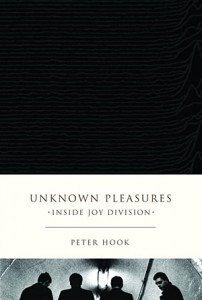In 1980, the three remaining members of Joy Division were faced with the challenge of moving forward without their lead singer, Ian Curtis, who had committed suicide on the eve of their first American tour. Neither the band, Curtis’ wife, or mistress saw it coming. Over time, in the absence of concrete truth, speculating and deification spun into a gilded mythology.
In his recent memoir, Unknown Pleasures: Inside Joy Division, the band’s bass player Peter Hook attempts to deflate the myth, or parts of it. Music writing can feel so “written,” but Hook’s voice is refreshingly immediate and present. Whether on the topic of wet-towel fights with the Buzzcocks, or the complicated circumstances of Curtis’ struggle with epilepsy, he maintains a level-headed grip on the past. The tender, yet unsentimental portrayal of his bandmate and friend is the ultimate tribute to Curtis, the person, not the legend.
David Nolan’s book I Swear I Was There: The Gig that Changed the World, along with films Control and 24 Hour Party People have done the legwork of immortalizing the Sex Pistols’ infamous June, 1976 Manchester show. Future Joy Division and New Order members, Peter Hook and Bernard Summer, as well as Steven Morrissey, later of the Smiths, and two members of the Buzzcocks reportedly attended. The junction carried uncanny portent for the future of post-punk and new wave movements.
Hook’s version of the event epitomizes his unassuming way of conveying how Joy Division came about. It all started with Johnny Rotten, dressed in a torn yellow sweater, “glaring out into the audience like he wanted to kill each and every one of us, one at a time.” At a later Sex Pistols show, he reflects, “the allure of punk started to fade for some of us,” citing their sound: “deliberately awful . . . feeding back, fuzzed-up, just a complete din.” Respectfully, it was what made him wonder if Rock and Roll could sound rough and experimental, but not like garbage.
This is not to say he was concerned with crowd-pleasing. “Joy divisions” referred to the groups of Jewish women detained by Nazi soldiers for sexual pleasure in concentration camps. The choice of band name had nothing to with the militant racism of “Nazi punk” groups coming out of the British National Front. It wasn’t even political commentary so much as a heady, if misguided, attempt at cultural appropriation, the fallout from which followed them around for years. “No way were we going to make that mistake again,” he half-jokes, in an effort to keep a straight face about the perplexing choice to name his next band “New Order.”
Occasionally, the book’s divided chronology trips over a non-linear tangent. Much like the turns in Joy Division’s career, Hook’s arrangement of events seems accidental. Describing himself as “a frustrated guitar player,” he tried to make his bass sound like a guitar. “She’s Lost Control,” for example, revolves around a prominent, leading bass line. “It’s a different way of playing, and it came through learning badly.” Eventually, the band ended up with the type of sound only good engineering could do justice to. But early on, they had neither the experience, nor the resources, to execute that level of producing.
Remembering their first record, he writes, “we lugged it from shop to shop trying to offload it as quickly as we could before word spread about the abysmal sound.” Then, a sad dust pile of give-aways; now, obscenely priced collector’s items.
Signing with Factory Records landed them in the hands of producer Martin Hannett, “a wizard surrounded by smoke and in charge of his strange machines.” Producing both of Joy Division’s only two full-length albums, Unknown Pleasures and Closer, his laborious, unorthodox practices are as dynamic in Hook’s recollection as they are on the recordings:
Martin wanted zero spill from the mikes, so he had to record each drum individually. Of course that meant that Steve was rarely playing his whole kit. He was allowed to play only one drum at a time and ghosted the others. So what happened was that we ran through “She’s Lost Control” live, then Martin recorded the drum track, we took the kit apart, and Steve played his parts again — one drum at a time.
When Curtis died, there was no consideration among the remaining three members to go on as Joy Division. He was not only their lyricist and voice, but also their ear. Only he could hear and edit them as they needed to be. His hypnotic stagecraft was also inimitable, as many of his mannerisms were symptoms of seizure, made worse and more frequent by the strenuous lifestyle of touring. There were episodes on stage during which he would stop singing and “fall over into the drum kit.” Determined to keep performing as a group, however, they built it into their sets, using powerful wash lights as a distraction, careful not to induce him further with anything too strobe-like. Though difficult to applaud, their morbid accommodation of his illness probably reflected his stubborn refusal to do anything but make and perform music. His bandmates knew this better than anyone.
Toward the end of the book, both albums are broken down track-by-track, through which Hook encourages simultaneous listening. In my case, this involved a lot of starting, stopping, and rereading, none of which I would have necessarily traded for a more fluid narrative. “Decades,” the last track on Closer, is long enough to play well into the concluding chapter, although again, it helped to cheat and replay the middle few minutes, stretching out the effect. Somehow, his obsessive fixation on the creative minutiae is neither narcissistic nor tedious, but rather, humbly energized. Just like his bass playing, fresh as ever.
This post may contain affiliate links.









